Today is far different from how things began before, especially in marketing.
The existence of thousands of tips and tricks has continued to increase on how to do perfect marketing for a business, where AIs have also already existed.
Despite all these new developments in this generation, email marketing has never lost its relevance due to its effectiveness.
As most marketers say, email marketing is still one of the easiest and most effective way to reach potential customers with a higher conversion rate.
Not only that. It also gives opportunity to your business to sell more products/services, engage more customers, and build overall business credibility
In fact, according to OptiMonster, 99% of users check their email every day.
What is Email Marketing
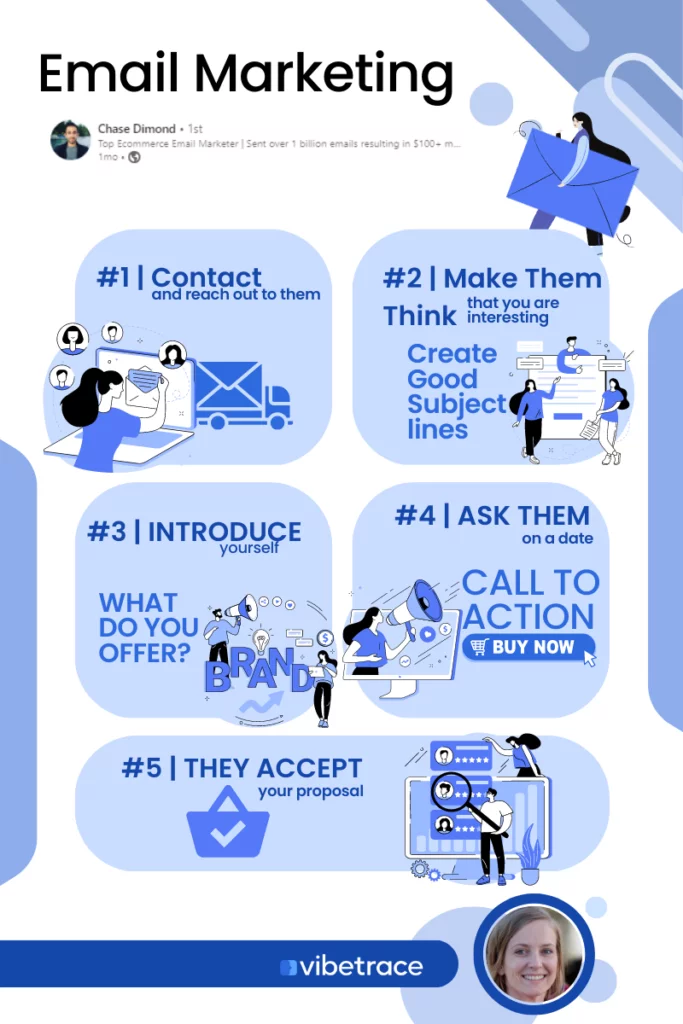
Email marketing is technically defined as a digital marketing strategy that involves sending commercial messages or promotional materials to a group of people via email.
The aim of email marketing is to promote a product or service, build brand awareness, or establish relationships with potential or existing customers.
Although the definition of email marketing can seem broad, Chase Dimond posted on a LinkedIn post saying “Email marketing is like dating”.
To help you understand how email marketing works, he sited the following things you do when you start doing email marketing which is like dating:
You contact them (email sent): You reach out to your prospects and make them feel valued for being part of your mailing list.
They think you’re interesting (subject line): First impressions are important, and a catchy and interesting subject line can capture their attention.
You introduce yourself (email content): In a sincere friendly message, you introduce yourself, your company, and how you can help.
You ask them on a date (CTA): The main goal of your email is to entice them to take action with a clear call-to-action. Same thing like asking them to say YES.
They accept (purchase): Success is when they accept your offer and make a purchase.
If you’ve gone on a date, you probably can do email marketing!
The 6 Main Components of Email Marketing
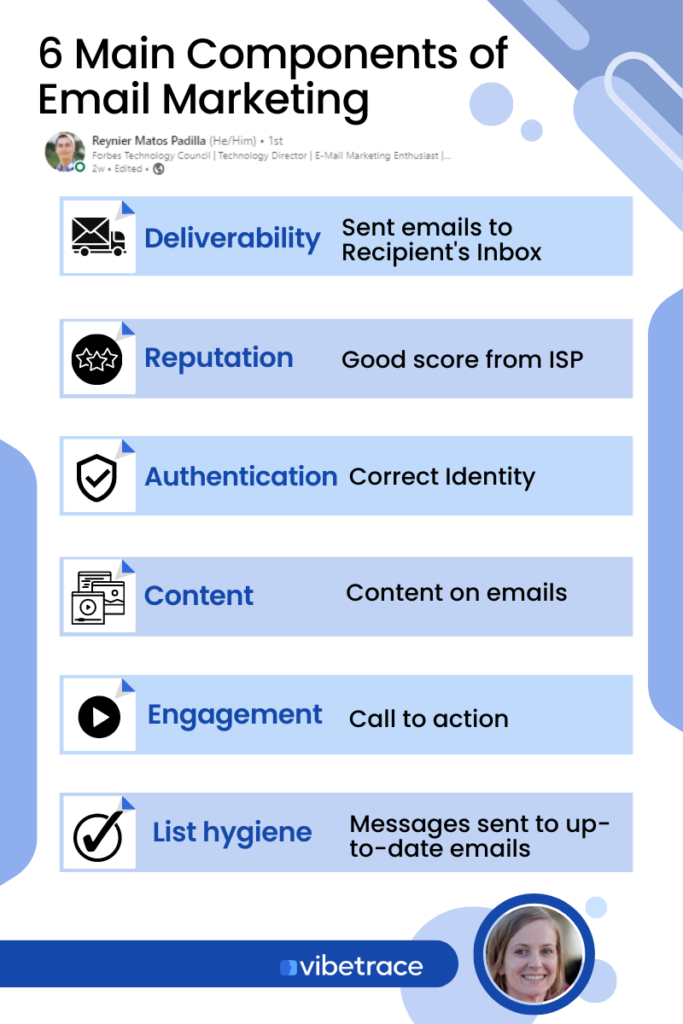
Boosting your email marketing game has no perfect formula to make sure that eventually, it will be successful but there are key components that you must check to give your business a higher chance for successful email marketing.
Reynier Matos Padilla, E-commerce Product Manager, has mentioned 6 main components that you should be mindful of when starting your email marketing.
- Deliverability (Does your email reach the inboxes of your prospects?)
Deliverability depends on your reputation, authentication, content, and engagement.
- Reputation (What is your score based on email history and behavior?)
A good reputation means higher deliverability.
- Authentication (Are you checking your identity when sending emails?)
Use SPF, DKIM, and DMARC to prevent spoofing or phishing.
- Content (What message do you write to your subscribers?)
Your content should be relevant, valuable, and engaging otherwise people won’t even care about what you say. Follow best practices to avoid spam or unsubscribes.
- Engagement (How do your subscribers interact with your emails?)
Engagement Includes open, click, reply, and forward rates. Thus, a high engagement rate means you are gaining high trust and interest.
- List hygiene (Are you keeping your list clean and up-to-date by removing invalid, inactive, or uninterested subscribers?)
Take note that a clean list Improves deliverability by reducing bounces, spam, or unsubscribing. Also, you can use tools such as verification services or re-engagement campaigns.
Do you like this article?
Join our CX for Retail dedicated newsletter!

Stay connected to what’s really important to optimize your digital revenues.
By clicking the button, you accept our Terms & Conditions. Also you will need to confirm your email address.
The 5 stages of eCommerce email marketing
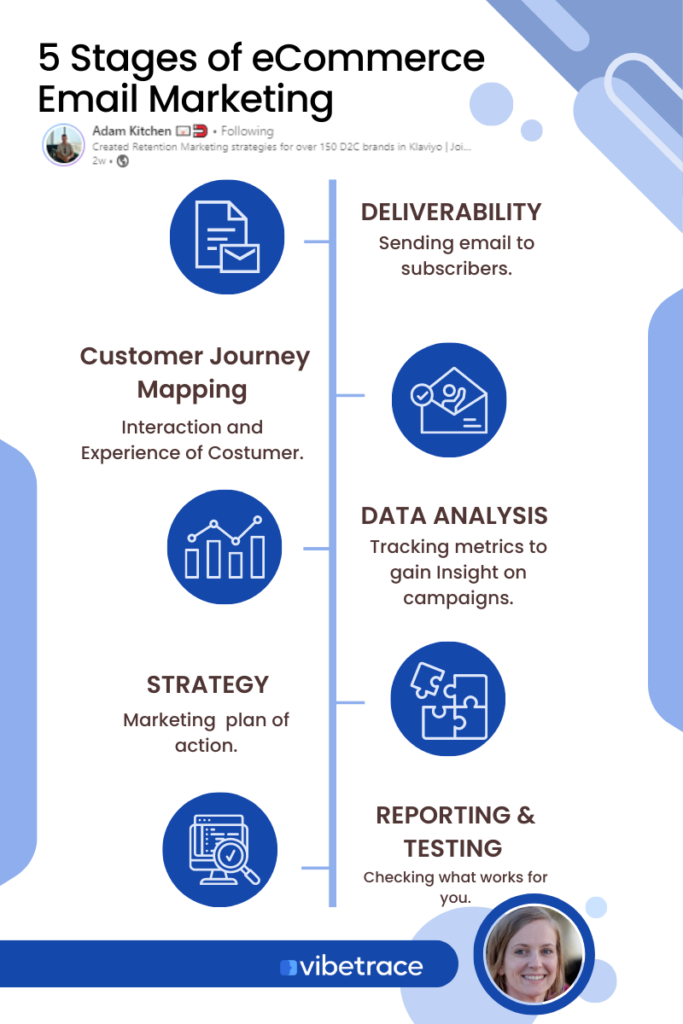
Email marketing requires a step-by-step process to make sure that your email marketing will be successful in converting people into customers.
Without the knowledge of how to organize your processes in making email marketing work, It’ll be harder for you to expect a high conversion rate.
The worst case scenario that may happen is you might even end up just throwing your dollars for no return.
So, Here are the 5 Stages of eCommerce Email Marketing by Adam Kitchen that could be your guide with email marketing:
Deliverability
Deliverability is defined as having your email sent to your subscribers’ inbox.
You can’t sell to people if they don’t see it.
That’s why deliverability needs to be the focal point of your email marketing strategy. If your messages are going to your recipients’ spam, it’ll make you lose your reputation and no one can ever read them.
Customer Journey Mapping
Customer Journey Mapping is a technique to visualize and understand the experience of your customers when interacting with your offered products, services, or brand.
The customer journey is divided into 3 core areas:
- Pre-purchase consideration
- Post-purchase
- Churn risk/lapsed customers
You need to understand and speak to customers and learn how to leverage data to connect with them at each stage differently here.
Data analysis
Data analysis can be done with the use of important eCommerce metrics that can provide you with insights that will be useful to track your email success.
Although that’s not all. Having a deeper understanding of the kind of product you offer and your customer behavior towards the product has a huge impact on analyzing your data as to when to send emails and when not to.
Each brand has customers who have different purchase behaviors that need to be taken into consideration.
Somebody who is buying wedding rings may need a longer nurture sequence than somebody buying protein powder.
Additionally, Consumers also churn at different points for each product.
Unless you go deep into the data, your messages may reach customers at the wrong time and be ineffective.
Strategy
Strategy is your marketing plan of action. Without any plan, you can be bound to fail.
Soo choose to strategize and put your vision into action. And If you’re now in a strong position to build your strategy across solid fundamentals, begin with Email/SMS automation.
This kind of marketing should be the priority in the beginning before you move to campaigns once you’re hitting a decent level in traffic and audience.
Reporting & Testing
Reporting and Testing can help you make sure that everything you did is on the right track!
Rigorously track defined email/SMS KPIs and commit to testing your current setup in the quest for infinite improvement.
Your job is never finished and there are always new initiatives to be working on.
The 5 Reasons to Use Email Marketing
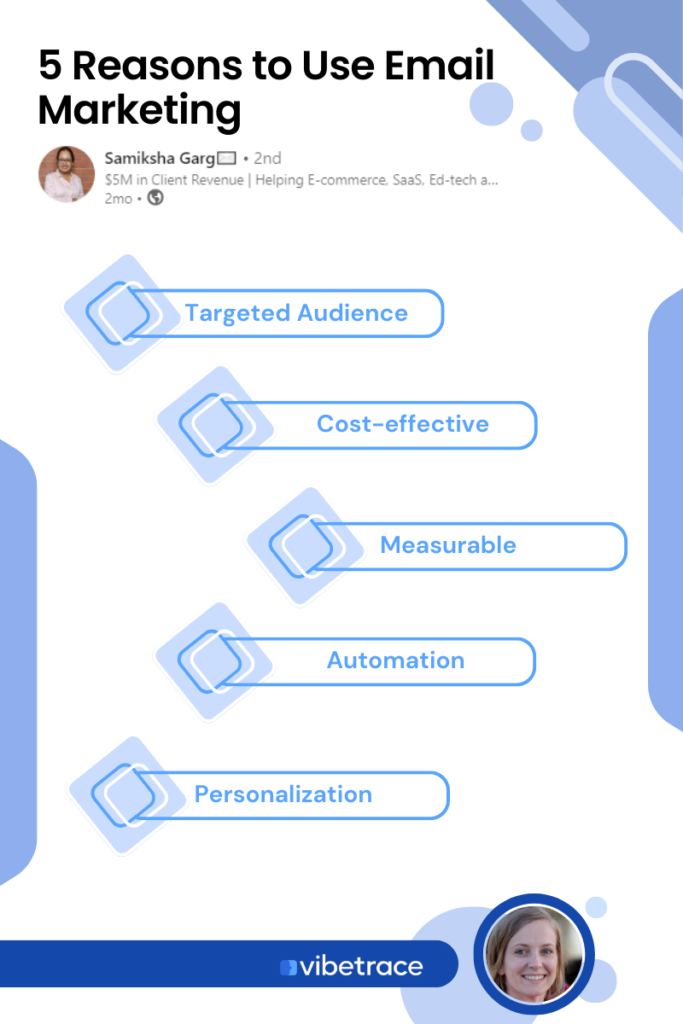
Email marketing is a powerful tool for e-commerce businesses according to Samiksha Garg. In her post she mentioned 5 main reasons why you have to use email marketing.
Here are a few reasons why:
Targeted audience
Email marketing provides businesses with the ability to tailor their messaging to specific groups of customers, based on their demographics, behaviors, or past interactions with the company.
For instance, businesses can send promotional emails to customers who have made a purchase in the past, or to those who have abandoned their shopping carts.
Email marketing campaigns can be highly personalized and relevant to the recipient by targeting specific customer segments.
This increases the chances that the customer will engage with the email and take the desired action, such as making a purchase or visiting the company’s website.
Cost-effective
One of the advantages of email marketing over other marketing channels is its cost-effectiveness.
Compared to traditional advertising methods such as print or TV, email marketing can be much more affordable, which means it can be a great option for businesses of all sizes, from small startups to large corporations.
Because email marketing does not require expensive printing or production costs, businesses can invest more of their budget in creating high-quality content that resonates with their target audience.
Additionally, many email marketing platforms offer pricing plans that are based on the number of subscribers or emails sent, allowing businesses to scale their campaigns as they grow.
Measurable
Email marketing campaigns provide businesses with detailed analytics that allow them to track and measure their performance.
This data can be incredibly valuable for businesses as it provides insights into how customers are interacting with their brand and their campaigns.
By tracking metrics such as open rates, click-through rates, and conversion rates, businesses can see which emails are resonating with their audience and which ones are not.
This data can then be used to optimize future campaigns, such as by adjusting the subject line or the call-to-action, or by testing different messaging and design elements.
Automation
Email marketing platforms provide businesses with the ability to automate their email campaigns.
This means that businesses can schedule emails to be sent at specific times or triggered by certain events, such as a customer making a purchase or abandoning their cart.
Automating email campaigns can save businesses a significant amount of time and resources, as they no longer need to manually send each email or segment their email list.
Instead, businesses can set up automated workflows that deliver targeted messages to customers at the right time, without requiring any additional effort from the marketing team.
Personalization
Email marketing allows businesses to personalize their communications with customers.
This can include things like using the recipient’s name in the subject line or the body of the email, tailoring the content of the email to match the recipient’s interests, or even offering personalized deals or promotions.
Overall, email marketing can be a powerful tool for e-commerce businesses, helping them to reach a targeted audience, save time and money, and personalize their communications with customers.
4 Myth-busting in email marketing
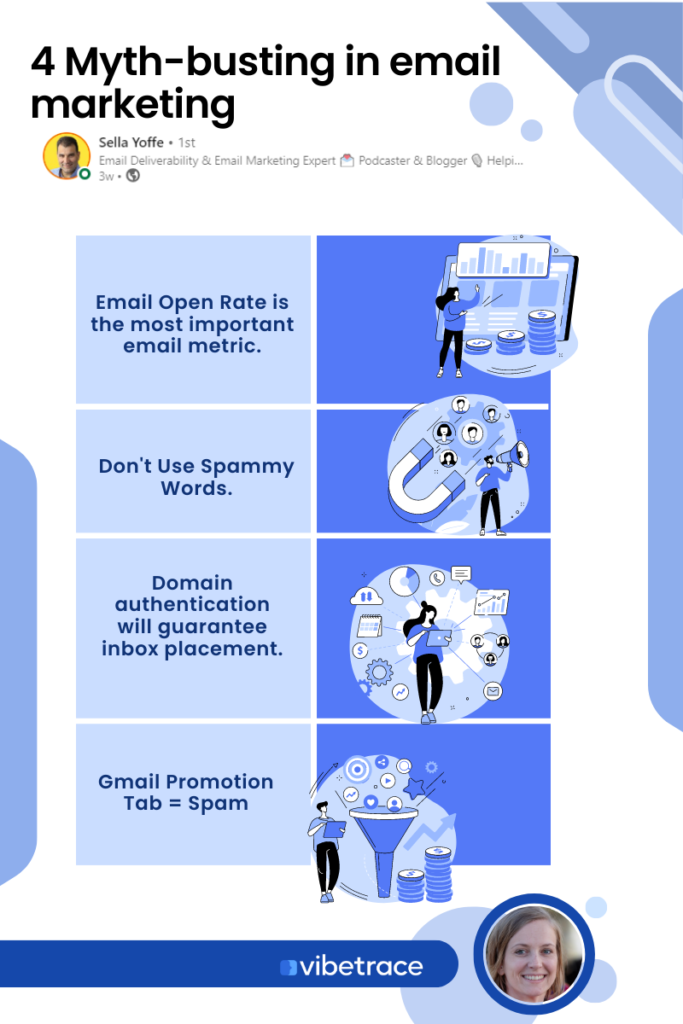
You probably have already done lots of research regarding email marketing and ended up feeling overwhelmed with tons of information in which you no longer could Identify truth and misconceptions.
According to a post by Sella Yoffe, there are several things that you have to understand to Clear up your misconceptions about email marketing.
Email Open Rate is the most important email metric
Email marketers have been incorrectly placing too much importance on open metrics as a measure of success. However, the truth is that open metrics have never been entirely accurate.
For instance, the act of opening and reading an email on MS Outlook will only register as an open if the recipient downloads the images. Conversely, simply clearing notifications from an inbox, without engaging with the email’s content, can also trigger an open metric.
The recent introduction of “image prefetching” by Apple in IOS 15 has further muddled the waters for email platforms. As a result, businesses may see a boost in their open rates, but this doesn’t necessarily translate into a higher engagement or conversion rate.
Open metrics are engagement metrics, not business metrics. To truly understand the impact of an email campaign on the bottom line, businesses should focus on metrics like Revenue Per Email (RPE), which measures the business impact of an email campaign.
To track the effectiveness of their email marketing program, businesses should view open rates as a weather forecast, rather than a definitive measure of success. Instead, they should use both click and open metrics to identify trends and optimize their strategy accordingly.
Don’t Use Spammy Words
In the past, email filtering relied heavily on identifying specific keywords or phrases (known as spammy words) within the subject and body of emails.
Emails containing words like “free” or “discount” were often flagged as spam using various tools within email platforms or external web tools that would assign a spam score to each email.
However, the use of spammy words is no longer a relevant factor in spam filtering for Gmail and other major mailbox providers. Instead, Gmail considers a variety of other factors to determine whether an email is promotional and should be sent to the Promotions tab.
That being said, the use of spammy words may still be relevant in certain situations, such as B2B emails, where keyword-based spam filtering is still utilized. In these cases, businesses should be mindful of the language they use in their emails to avoid triggering spam filters and ensure their messages reach their intended recipients.
Overall, email filtering has evolved beyond simply scanning for spammy words and now takes into account a range of other factors to determine email placement and deliverability.
Domain authentication will almost guarantee inbox placement.
When sending emails through your ESP, if you see “via” or “on behalf of” in the sender information, it means that you are using a shared domain instead of your own domain.
This can negatively impact your email deliverabilityf and email sending reputation.
To improve your email deliverability and take control of your email-sending reputation, it’s important to authenticate your domain.
This is a crucial initial step for brands to ensure that their emails are not flagged as spam or phishing attempts.
It’s worth noting that each domain can only have one SPF record, and the DNS lookup limit is set to a maximum of 10.
Therefore, it’s important to verify the accuracy of your records, and you can use free tools like kbxscore.com to do so.
By authenticating your domain and ensuring the accuracy of your records, you can significantly improve your email deliverability and avoid being flagged as spam or phishing attempts.
Gmail Promotion Tab = Spam
Gmail was first launched by Google on April 1st, 2004. In 2013, a significant change was made to the Inbox, whereby it was organized into seven categories to enhance filtering and searching capabilities.
One of the categories introduced is the Promotion Tab, which is dedicated to commercial emails, sales emails, deals, newsletters, offers, emails that include a call to action, and emails originating from mailing lists (which Gmail can identify as such).
The Promotion Tab = Inbox
The Spam folder in Gmail is entirely separate.
Gmail Promotion Tab=SPAM
A survey by Validity showed that only about 20% check the Promotion Tab.
Therefore, they are probably not potential buyers.
Although it is possible to jailbreak out of the Promotion tab, I wouldn’t put much effort into it. A new Promotion Tab was launched in 2018 with a number of benefits for marketers, including Gmail Annotations.

